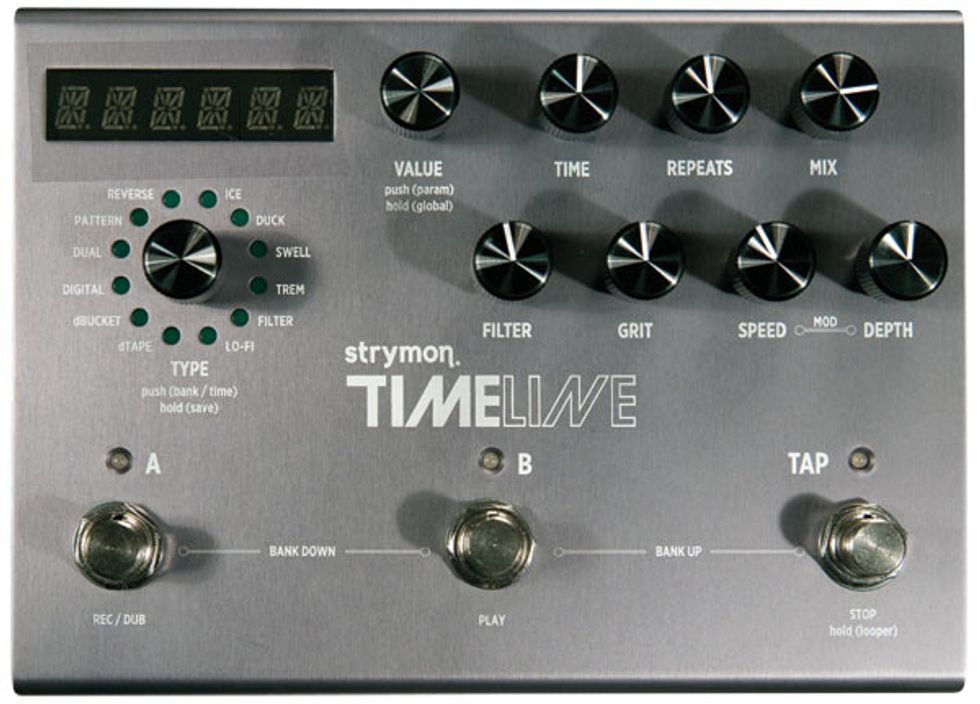At this point, most guitarists familiar with
Strymon are accustomed to having the
company knock their socks off. In the last
couple of years, this Southern California-based
group of hardcore pedal geeks has garnered
raves in these pages for their Blue SkyReverberator (July 2010) and El Capistantape-delay emulator (November 2010). The
company’s latest weapon for sonic tweaking,
the TimeLine delay, is every bit as impressive.
And if you’re a studio hound—home,
pro, or otherwise—the TimeLine is worth
your undivided attention.
Pure Function
Strymon says the TimeLine is inspired by
studio-grade outboard delays, and the pedal’s
super-functional and get-down-to-business
control layout is a reflection of the muse.
The gunmetal gray box may look busy compared
to other stompbox delays, but given
the enormous wealth of functions within, it’s
actually quite streamlined. The seven knobs,
arrayed asymmetrically on the right side of
the pedal, modify the delayed signal in both
basic ways (time, repeats, mix) and more
radical ones (grit, filter, and modulation
rate and depth.) An eighth knob accesses
additional parameters for each effect. Twelve
delay types can be selected with the Type
knob on the left, which can also be pushed
to save presets. The three footswitches serve
dual functions, enabling you to activate two
preset banks, control the looper’s play and
record functions, and tap out tempos.
Worlds of Echo
There’s no way to cover everything the
TimeLine can do in a single review, but
while it’s a pedal of formidable power, its
intuitive enough that you can jump right
in and conjure about a trillion cool sounds
immediately. The 12 delay “machines,” as
Strymon calls them, include the dTape tapeecho
simulation that’s at the core of the El
Capistan pedal, the company’s dBucket analog-
delay emulation, and a digital delay—all
of which will delight discerning traditional
tonehounds. But the less-conventional delays
are where the real fun starts. Dual delay adds
a second set of repeats that lend a spacious,
reverb-like ambience that fans of Radiohead’s
Ed O’Brien and Jonny Greenwood will
adore. The Ice setting is similarly cosmic,
though it does the cool trick of slicing and
dicing the delayed signal and playing them
back as though they were shards of a broken
mirror. And with a capo on the 7th fret of
my Danelectro Hodad 12-string, the simplest
folk arpeggios became a celestial choir.
The Filter delays enable the addition of
a synchronized low-filter oscillator to the
delayed signal, as well as resonance adjustment
that lends a synth-like tweak and a
little mid-’70s Jerry
Garcia vowel tone
to the repeats. The
Swell setting gives
your repeats an
almost volume-pedal
like bloom. Trem
lends a cool pulsating
warble, while
Reverse, when used
on bendy, Eastern-flavored
lines with
a longer delay time
and fewer repeats,
is a vehicle for
mind-bending psychedelic
leads.
The dTape and dBucket machines have
their own unique set of functions that are
assigned to the Filter, Grit, Depth, and
Speed controls. For instance, in dTape mode,
the Filter control becomes a Tape Age emulation,
while the Speed control emulates Tape
Crinkle at various levels of decrepitude.
Other delays use the Filter, Grit, and Depth,
and Speed knobs in a more straightforward
manner. But they are highly editable in
other ways through use of the Value knob,
which can be depressed to give you access
to another level of performance-modifying
options. The Ice mode, for instance, has a
an Interval control that enables to you to
tailor the pitch intervals of repeats from
one octave down to two octaves up, with
everything from major thirds and minor
sevenths in between. I used this function to
craft very song-specific harmonies. All such
settings can be stored as presets, as well.
The Verdict
While the TimeLine is an amazing tool
in live contexts, many players will find it
incredibly expressive in the studio, too. In
addition to the deep functionality of the
unit at the most immediately accessible
levels, each delay machine can seem almost
infinitely tweakable to suit a musical situation.
All this processing power isn’t cheap,
but given that this Strymon may lead you
to abandon every delay in your collection
except perhaps your bar-gig unit, it could
well be worth every cent over the long haul.
Buy if...
you have a producer’s ear for delectable delays and an insatiable appetite for echo in all its forms.
Skip if...
simply using your existing delay unit’s tap-tempo functionality makes your brain hurt.
Rating...
Street $449 - Strymon - strymon.net |









![Rig Rundown: Russian Circles’ Mike Sullivan [2025]](https://www.premierguitar.com/media-library/youtube.jpg?id=62303631&width=1245&height=700&quality=70&coordinates=0%2C0%2C0%2C0)

















